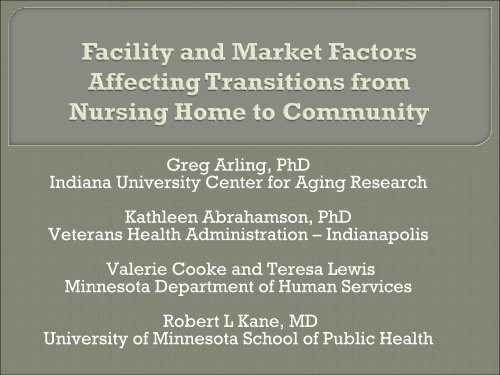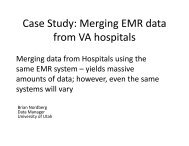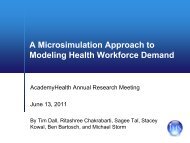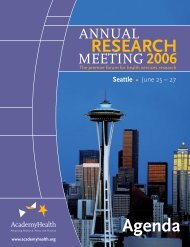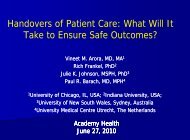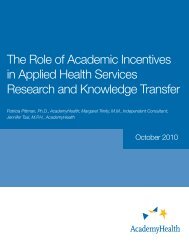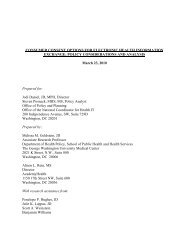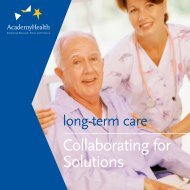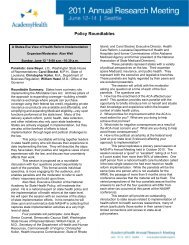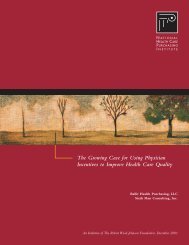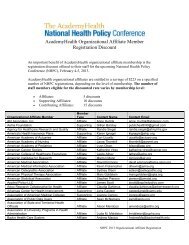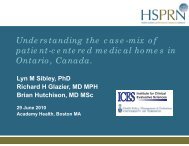Greg Arling, PhD Indiana University Center for Aging Research ...
Greg Arling, PhD Indiana University Center for Aging Research ...
Greg Arling, PhD Indiana University Center for Aging Research ...
You also want an ePaper? Increase the reach of your titles
YUMPU automatically turns print PDFs into web optimized ePapers that Google loves.
<strong>Greg</strong> <strong>Arling</strong>, <strong>PhD</strong><br />
<strong>Indiana</strong> <strong>University</strong> <strong>Center</strong> <strong>for</strong> <strong>Aging</strong> <strong>Research</strong><br />
Kathleen Abrahamson, <strong>PhD</strong><br />
Veterans Health Administration – <strong>Indiana</strong>polis<br />
Valerie Cooke and Teresa Lewis<br />
Minnesota Department of Human Services<br />
Robert L Kane, MD<br />
<strong>University</strong> of Minnesota School of Public Health
Determine the influence of facility and<br />
market characteristics on community<br />
discharges from Minnesota nursing<br />
homes<br />
Apply findings to a statewide<br />
intervention to promote resident<br />
transitions from nursing home to<br />
community
Individual, facility, and community<br />
characteristics likely combine to<br />
influence transitions from nursing<br />
home to community<br />
Yet, prior research has focused on<br />
individual characteristics excluding<br />
the context of the discharge process
Community discharges are concentrated<br />
heavily in the first 90 days after admission<br />
Resident-level factors were highly<br />
predictive of community discharge – health<br />
and functional status, pay source, and<br />
resident preferences<br />
Yet, a sizable proportion of residents who<br />
became long stay preferred returning to the<br />
community (64%) and seemed capable of<br />
doing so (40%)<br />
Why did they remain in the facility?
Facility staff do not recognize or support<br />
the resident’s desire to return home<br />
Facilities do not have the resources or<br />
services to facilitate transitions<br />
Transitions threaten facility revenue,<br />
e.g., reduced occupancy<br />
Community based long term care<br />
(CBLTC) alternatives are unavailable
Sample<br />
• Annual cohort (July 2005-June 2006) of 22,469<br />
admissions to 380 Minnesota nursing homes<br />
Data Sources<br />
• Resident – MDS assessments at admission and<br />
90 days<br />
• Facility – State Medicaid cost reports and<br />
administrative systems<br />
• Market – Area Resource File and state<br />
administrative systems
Resident having a preference (MDS: H1a)<br />
or support (MDS: H1b)<strong>for</strong> returning to the<br />
community as recorded by NH staff at<br />
admission<br />
• Preference OR Support =1<br />
• Neither Preference nor support = 0<br />
Community discharge within 90 days of<br />
admission<br />
• Discharge to home or assisted living = 1<br />
• Remained in the facility, died, or nursing home<br />
transfer = 0
75 markets representing individual or<br />
combinations of contiguous Minnesota<br />
counties<br />
Market defined according to:<br />
• Among facilities in the market, the % of nursing<br />
home admissions coming from that market<br />
• Among persons in the market who are admitted to<br />
nursing homes, the % entering a facility in that<br />
market<br />
Counties making up the markets are the<br />
primary locus <strong>for</strong> community care funding<br />
and delivery
Resident-level hierarchical general linear<br />
models (HGLM) with P/S and CD as<br />
outcomes and facility and market as random<br />
effects<br />
Facility-level empirical Bayes (EB) residuals<br />
estimated from resident-level models<br />
Facility-level hierarchical linear models<br />
(HLM) with adjusted facility PS and CD rates<br />
(EB residuals) as outcomes and market as a<br />
random effect
Model the resident’s<br />
• Preference/support<strong>for</strong> community discharge<br />
• Community dischargewithin 90 days of<br />
admission<br />
Adjust <strong>for</strong> resident-level covariates<br />
• Admission source – hospital or community<br />
• Pay source - Medicare or Medicaid<br />
• Major diagnoses – hip fracture or end-stage<br />
disease<br />
• ADL dependency, cognitive status, &Continence
Produce adjusted facility-level rates<br />
• Proportion of residents preferring or support <strong>for</strong><br />
community discharge<br />
• Rate of community discharges within 90 days of<br />
admission<br />
Adjusted facility rates are estimated as<br />
empirical Bayes (EB) residuals representing<br />
• Variation that remains between facilities in their<br />
rates of preference/support and community<br />
discharge<br />
• After controlling <strong>for</strong> the characteristics of their<br />
residents
Examine relationships between adjusted<br />
facility-level rates of preference/support<br />
and community discharge and<br />
• Facility characteristics<br />
• Market characteristics<br />
HLM models<br />
• Level 1: facility<br />
• Level 2: market<br />
• Market treated as a random effect
Facilities having a higher proportion of<br />
residents preferring or having support to<br />
return to the community (adjusted)<br />
• Higher average resident acuity<br />
• Higher percentage Medicare and lower<br />
percentage Medicaid residents<br />
• More nursing hours per resident day<br />
• Located in markets with high average NH<br />
occupancy
Facilities having a higher community<br />
discharge rate (adjusted )<br />
• Higher percentage of Medicare residents and<br />
lower percentage Medicaid<br />
• More nursing hours per resident day<br />
• Higher facility occupancy rate<br />
• Higher percentage of residents preferring or<br />
having support <strong>for</strong> community discharge<br />
• Located in markets with more CBLT recipients in<br />
relation to NH recipients
Facility business model emphasizing<br />
• Post-acute care&diversified revenue streams<br />
(particularly Medicare and private pay)<br />
• While Maintaining high occupancy levels<br />
Sufficient nursing staff resources to<br />
prepare residents <strong>for</strong> transitions<br />
Facility culture that respects resident and<br />
family preferences<br />
Availability of CBLTC alternatives in the<br />
local health care market
Community agencies should take the lead<br />
in transition counseling, patient education,<br />
CBLC referrals, etc.<br />
Nursing facilities need to plan <strong>for</strong> and<br />
facilitate transitions<br />
Intervention should be targeted at<br />
residents:<br />
• Early in the NH stay (90-180 days)<br />
• Want to return to the community<br />
• Otherwise would become long stay<br />
Targeted at facilities with low community<br />
discharge rates
States should enact policies that encourage<br />
facilities to:<br />
• Reduce their unused bed capacity<br />
• Balance their mix of payers<br />
• Invest in nurse staffing<br />
• Take other steps to develop business models<br />
consistent with state goals <strong>for</strong> long-term care<br />
rebalancing<br />
States should expand HCBS funding,<br />
particularly in markets with low community<br />
discharge rates


